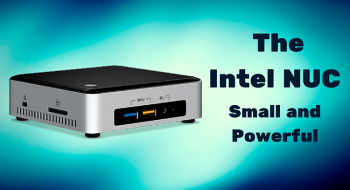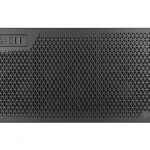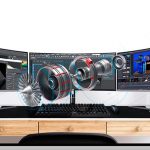Virtual reality technologies and their practical applications are becoming more and more popular. At the dawn of its development, the equipment was bulky, complex to install and the software setup procedure was quite complicated, not to mention a very limited number of people could get an access to it both technically and financially. However, not so long ago the situation has changed dramatically. In 2012 Oculus released their first breakthrough virtual reality head-mounted display and developer kit – the Oculus Rift.
This gear and software has opened the doors to a greater number of VR developers and enthusiasts at an affordable price, but more importantly it was becoming popular and well known amongst a wide number of users, the more questions were being asked whether home gaming computers are able to handle it. And although we’ve mentioned that VR technologies are more affordable nowadays, the answer is likely to be a bit disappointing for some users – their PCs might still not be ready to handle the demands of VR applications. So, the ultimate question is – what are the system requirements for custom PCs that would able to handle VR technologies such as the Oculus Rift?
Before we get too technical, it is worth to mention that along with Oculus, there are a number of other advanced VR developments that have been announced not so long ago, such as Samsung Gear VR (for Android smartphones), HTC Vive (co-production with Valve), Sony PlayStation VR (for the PlayStation), Windows Holographic and some others. All these projects are in different stages of development and not yet fully implemented to a final consumer products. So, we will focus on the Oculus Rift as it’s already available for developers and consumer version is just about to be launched in the first quarter of 2016. The HTC Vive is similarly scheduled for release in April of 2016.
How does VR work?
Virtual reality requires a high frame rate to be able to move smoothly and naturally within a virtual space. It is a core requirement not only for an enjoyable 3D experience itself, but also in order to prevent so called “simulation sickness”, which might cause dizziness, headaches or even nausea.
The Oculus Rift has two Low Persistence OLED panels for each eye, with resolution of 1200×1080 pixels and with refresh rate 90 Hz. And this is a global refresh we are talking here – not scanning out in lines. Low persistence allows displaying an image for two milliseconds of each frame. The combination of the high refresh rate, global refresh and low persistence will prevent users to experience motion blurring or judder, which is usually experienced on a regular desktop monitor. As a result, the user experiences an almost tangible feeling of the virtual environment and objects in it.
As we can see here, the resolution and the frame rate are demanding enough for any system and many normal PCs won’t come even close to such rate to be able to handle the VR application or game. Not to mention that resolution has to be considered as double – 1200×1080 per display = 2400×1080 pixels. Considering this, a comparison example of what computational power will be required to get a pleasurable experience, can be given as following: a traditional game with 1080p resolution at 60Hz frame rate requires about 124 million shaded pixels per second, whereas the Oculus Rift runs on dual-displays at 2400×1080 resolution at 90Hz frame rate that require about 233 million shaded pixels per second. But what makes it even more challenging is that at the default eye-target scale, the Rift’s rendering requirements go much higher: around 400 million shaded pixels per second. This means that by raw rendering requirements alone, a VR game or application will require approximately 3x (!) the GPU power of traditional 1080p gameplay.
System requirements
Here are the minimum system requirements that Oculus has provided:
- A dedicated NVIDIA GTX 600 or AMD Radeon HD 7000 series graphics card with HDMI or DVI-D output ports
- two USB 2.0 ports (at least one them is powered)
- Windows 7 or Windows 8 operating system
As an additional recommendation to a minimum specs it is recommended that your dedicated graphics card should be capable of running current generation 3D games at 1080p resolution at 75fps or higher. Unfortunately, Oculus doesn’t mentioned CPU and RAM minimum requirements, but we assume it shouldn’t be lower than Intel Core i5/AMD A series CPUs and 8+ Gb of RAM.
At AVADirect we recommend the following minimum system specifications:
- Intel i5-4590 processor equivalent or greater
- NVIDIA GTX 970 / AMD 290 equivalent or greater
- 8GB+ RAM
- Compatible HDMI 1.3 video output
- 2 USB 3.0 ports
- Windows 7 SP1 or newer
According to Atman Binstock, chief architect at Oculus, “The Rift will be capable of delivering comfortable presence for nearly everyone. However, this requires the entire system working well…We believe this ‘it just works’ experience will be fundamental to VR’s success.” Binstock also states that most likely, the Rift will be a device for desktop PCs owners, meaning that almost no current laptops meet Oculus’s minimum requirements in order to get full experience. However, the new Avant line of gaming laptops from AVADirect will certainly provide enough performance to power an Oculus Rift.
There are also other exciting new developments that could change the situation and lower the performance requirements can be considered as well: VR optimized GPUs, VR displays that will be able to run at lower than native resolutions, DirectX 12 performance improvements, optimization of VR compatible games and applications towards simple and easy to render graphics.
As a piece of advice here for custom PC builders: in the case that you decide to invest money into either an upgrade of you current system or to build a new one from scratch in order to be compatible with modern VR gear, make sure that it will still be relevant in the next 6 to 12 months. If you have the graphics card that already meets the minimum requirements, try to avoid spending your money for today’s top of the line GPUs, which would give you a slight performance boost at quite substantial cost that will have a reduced value by the arrival of the new, next generation VR optimized GPUs.









No comments yet